At one point or another, every industry and business on the planet has been forced to face incredible change and disruption. However, with change and disruption, brings incredible opportunities to innovate and reimagine their go-to-market strategy and operating model. Whether in the manufacturing facility, retail outlet or technology lab, Korn Ferry has not only had a front row seat to these transformations but has been alongside organizations and their leaders on their change journeys. One constant among all the organizations who come out on top is they have the talent it takes to win.
Now, as college athletics experiences this massive period of change, many have noted the pace of play is hard to keep up with. A new paradigm shifts with each passing week, and whenever it seems like the eye of the storm has passed, a new lawsuit sweeps in from the aether and the dark clouds gather anew, reinforcing a message that should at this point be clear: Now isn’t the time to board up the windows. Now is the time to build an ark. Because when the floods finally recede, nothing will be the same, and in this new landscape it will be critical to know not only who’s going to lead, but what type of leadership will be needed. As this change happens, the status quo leadership profile including traits, drivers and competencies must evolve too. That’s where the Enterprise leader comes in. A world class, agile executive, trained and coached to inspire and lead in a dynamic environment every day, shaping the enterprise to WIN.
To that end, Korn Ferry and D1.ticker partnered to invite 24 current athletic directors and executive-level leaders positioned to guide the industry into the future to take the Korn Ferry Four Dimensional (KF4D) leadership assessment. Built over the last 50 years, the KF4D takes a “whole person” view of leaders, providing information about how they typically prefer to work as measured against 56 elements. For the assessment, Korn Ferry compared this cohort of college leaders’ scores to the benchmark scores of the aspirational Enterprise Business Leader success profile in order to quantify current strengths and identify areas for improvement.
Why enterprise leadership?
CEOs today are leading in a world moving through crisis and disruption—where challenges have no known solutions, or if they do, there are far too many choices and few clear ones. Yet even while driving change amidst all this uncertainty, CEOs need to keep the trains running on time. Sound familiar?
An enterprise leader operates at multiple levels simultaneously to both run the organization and change the organization and is agile in the areas of strategic leadership, results leadership, people leadership and ecosystem leadership. At present, Korn Ferry research shows that below 14% of executives could be considered Enterprise Leaders while organizations led by enterprise leaders experience EBITA growth at a rate 6.7% faster than their peers.
“Enterprise leaders are those who sit at the helm of highly transformational companies that deliver extraordinary results,” says Korn Ferry Head of Collegiate Sports Jenna McLaughlin. “They perform and transform. So, we see a lot of comparables of our cohort to their counterparts in business; however, to level up, all business leaders should aim to become enterprise leaders. As college athletics continues to evolve, athletic directors must now respond to multiple stakeholders simultaneously, all while they handle challenges more complex, situations more ambiguous and duties more significant than their predecessors faced which is where enterprise leadership comes in.”
So, how is this cohort positioned against the Enterprise Business Leader success profile? Let’s take a look.
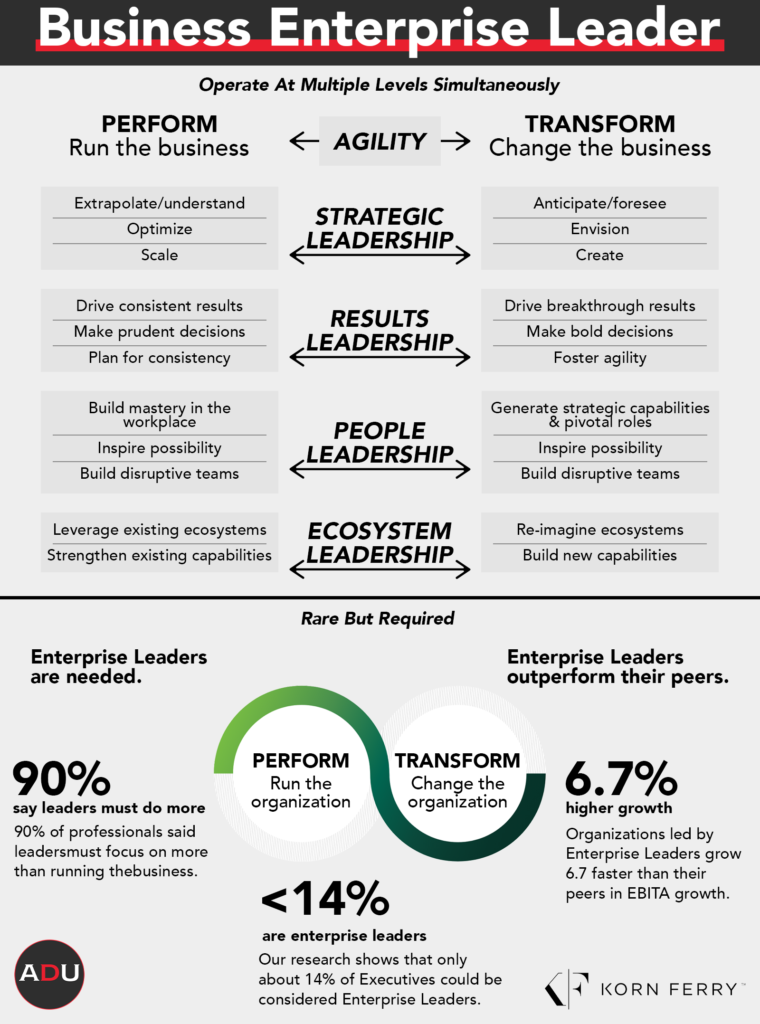
Where are we now?
The first assessment result that jumps out is our cohort’s average score in the area of strategic mindset, which Korn Ferry defines as “seeing ahead to future possibilities and translating them into breakthrough strategies.” For this metric, the college athletics leaders’ score of 5.82 slightly exceeds the Enterprise Business Leader profile score of 5.8.
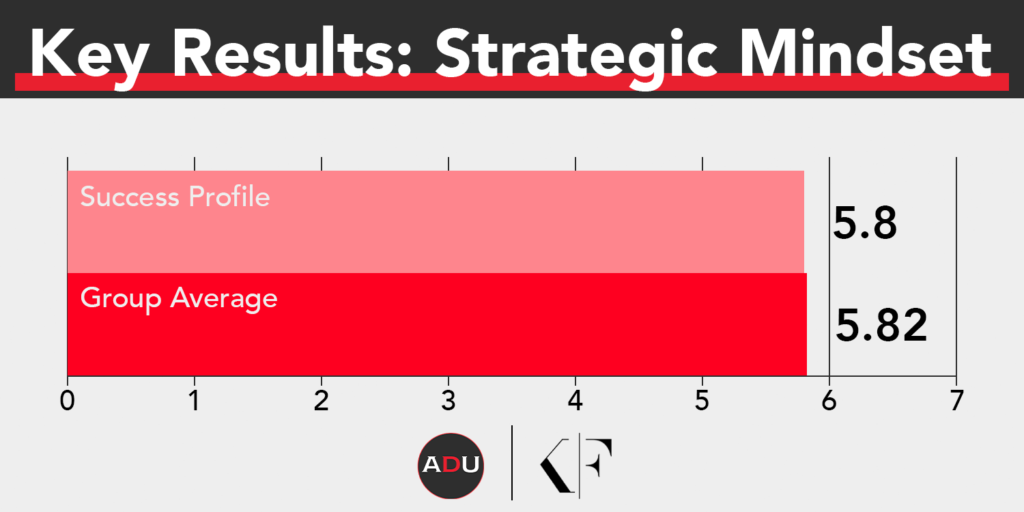
Leaders who excel in strategic mindset often possess a remarkable ability to envision future possibilities and develop innovative strategies. However, this strength can sometimes lead to challenges in execution. By over-indexing their strategic mindset, Athletics Leaders and Business Leaders alike may suffer from “analysis paralysis”where they become so focused on evaluating every detail that they struggle to make timely decisions and take bold action that address short term issues due to prioritization of long term goals.
Between NIL, the potential House settlement, and the barrage of other changes, the complexity of issues can cause strategic athletics leaders to get bogged down in the details delaying decisive action. Despite these issues, the demand to deliver on short term goals such as increased revenue and, above all else, a top student athlete experience, nevertheless requires actioning their plan despite the uncertainty.
Another KF4D result in which the cohort over-indexed the Enterprise Business Leader profile was in the competency of collaborating, which Korn Ferry describes as “builds partnerships and works collaboratively with others to meet shared objectives.” As you can see, college athletics leaders scored a 6.22 versus a benchmark of 6.1.
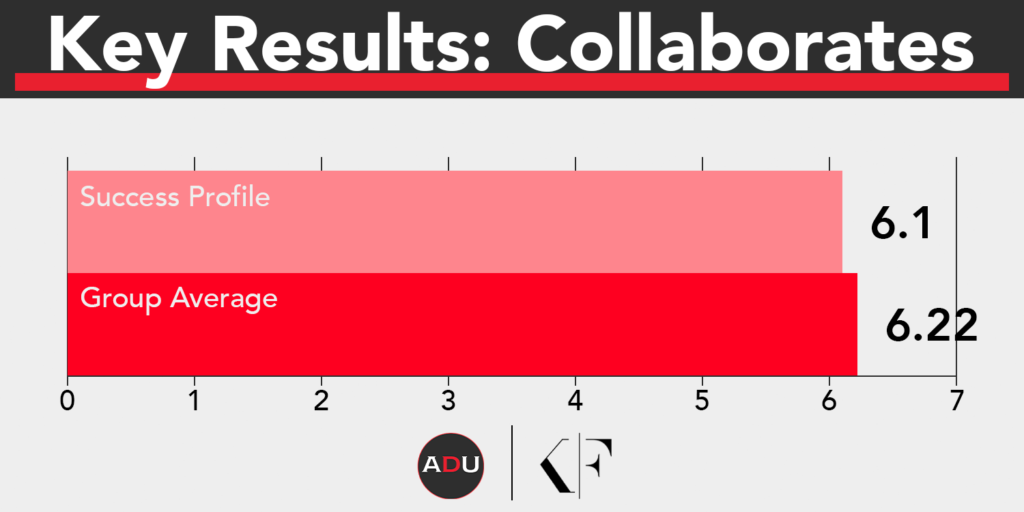
Like we see in their business leader counterparts, collaboration is a requisite skill for athletic directors to get anything of value done. As such, these leaders understand the value of collaboration. These leaders excel at forming strong relationships and partnerships to create synergy and achieve common goals. This all leads to more efficient use of time and resources and the easy exchange of ideas. However, overusing this skill can mean leaders are overly consensus-driven and struggle to make tough decisions in a timely manner.
Athletic directors are constantly required to work with their cabinet team, coaches, university leaders, student athletes and fellow conference leaders to achieve goals. As college athletics undergoes this period of disruption, collaboration will be key for top athletic directors for facilitating an open dialogue and sharing best practices across campuses and within conferences to drive forward through transformation.
Whether in the boardroom or in the athletic department, leaders can’t fulfill their missions or achieve their goals by themselves. These leaders understand the internal and external stakeholders around them and how to balance their needs, expectations and requirements. However, when leaders spend too much time clarifying stakeholder’s needs or trying too hard to please all stakeholders, it can slow decision making down and distract them from other higher value priorities.
Athletic directors have always had a multitude of stakeholder relationships, but the evolving world of college athletics is forcing ADs to reevaluate the priority order of these stakeholders. From the president and board, to student athletes, coaches and staff, fans, alumni and boosters, and now even state legislatures, it may be nearly impossible to please all groups. It will be key for college athletics leaders to understand who their stakeholders are, at what points to engage with them and consider the costs of not meeting each group’s needs.
To that end, KF4D found that college athletic leaders outpace the Enterprise Business Leader profile in the area of balancing stakeholders, which involves anticipating and balancing the needs of multiple stakeholders. For this competency, the cohort exceeded the benchmark score of 6 with an assessment score of 6.23.
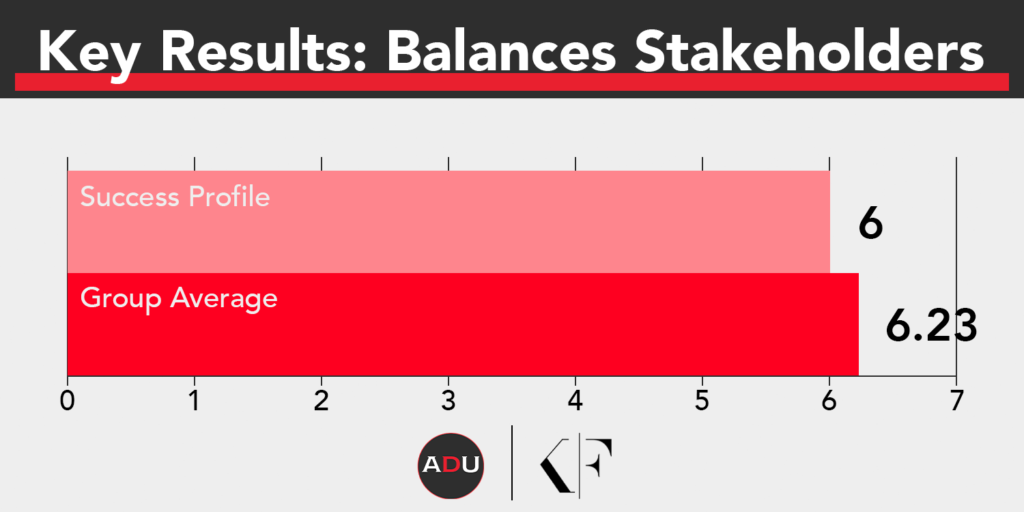
Leading through uncertain times is a challenge all business leaders face, and the college sports industry is certainly no different. In a period where the rules themselves aren’t always clear, the KF4D shows the college athletics cohort lags behind the Enterprise Business Leadership profile’s benchmark score of 5.9 with an assessment score of 3.5.
In today’s world, clarity is scarce and certainty is fleeting. Businesses are faced with new customer demands, new technology and new legal and regulatory orders. Relying on solutions that have worked in the past may seem safe, but it’s actually risky. New times require new solutions. Solving problems and getting things done in this volatile context means being willing to forge ahead when the path is foggy, at best and to surrender the need to be sure. Lower scores in this skill suggests a preference for control, avoidance of risk and desire to hold onto the past.
The deep-rooted traditions of college athletics are what makes it so beloved, but those traditions also challenge the industry’s evolution. The historic conferences and rivalry games that fans learned to love may be a thing of the past. Top athletics leaders must acknowledge this, shift gears and welcome it. As college sports moves towards a new model, the expectations remain the same: win and provide student athletes a transformative experience. Even with these expectations, athletic directors must understand that perfectionism will only hold them back. Instead they should experiment with small steps rather than trying to solve everything at once while staying agile enough to pivot.
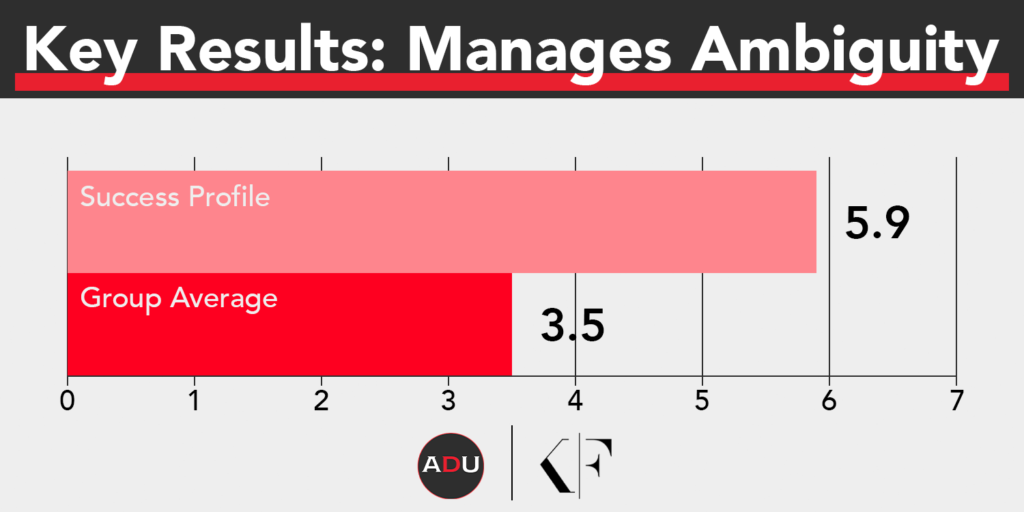
Another assessment result the KF4D identifies as an area for improvement involves customer focus, which entails building strong customer relationships and delivering customer-centric solutions. With an assessment score of 4.44, the cohort trails the benchmark score of 6.1.
At the end of the day, our businesses and even athletic departments exist to serve the customer. Top business leaders understand customers are the most important people in any organization and every action must be taken with them in mind. Being successful requires understanding who your customer is, paying close attention to their needs and adapting as their needs evolve. Lower customer focus scores indicates leaders are conducting work activities from an internal operational standpoint and may not be building effective relationships with key customers.
The nature of an athletic director’s responsibilities has historically been very operational. With revenue sharing around the corner, and ADs focus must shift to a more commercially oriented and externally focused mindset.Furthermore, as NIL and the transfer portal have turned college athletics on its head and altered the concept of amateurism, recruiting and retaining top student athletes has shifted the customers away from just the typical customers being defined as fans and boosters.
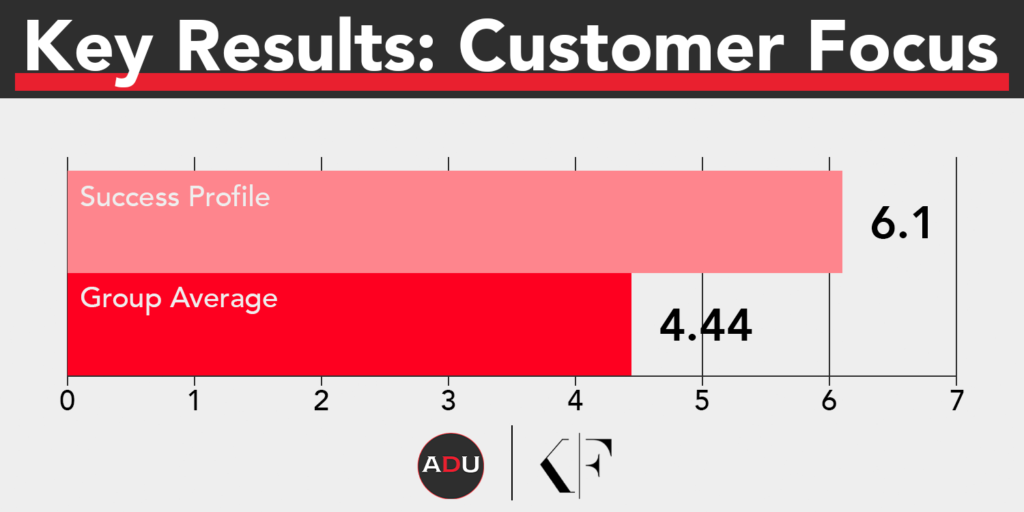
Where do we go from here?
As college athletics continues its headlong march into the winds of fundamental change, it is incumbent upon the next generation of college athletics executives to evolve into enterprise business leaders not just individually, but also collectively. Doing so will stabilize the industry and position it for growth while also supporting the industry’s most critical mission: the betterment of student-athletes.
One participating athletic director acknowledged as much, saying, “This exercise and assessment provided critical insight and analysis to stimulate thought-provoking discussion. Maximizing outcomes for very complicated situations starts by better understanding and knowing yourself.”
Another AD added, “Very rarely do we get an opportunity to slow down and do some introspection, so seeing as a cohort the similarities and differences of athletic directors in comparison to corporate business leaders in other industries was informative.”
Leaders in college athletics are facing increased pressure as the industry rapidly evolves. Their roles are shifting in real time, demanding a new level of business acumen and sophistication. While it starts at the top, athletic directors need to be future-ready, and so do their organizations. The pace of change and evolution of work is faster than ever. What worked well yesterday is unlikely to satisfy the demands of tomorrow. To succeed, leaders and their teams require constant upskilling, new talent, new structures and operating models, and agile culture to drive innovation. Korn Ferry partners with leaders to identify the talent they have today compared to the demands of the future and helps bridge the gap. It all starts with people! Better leaders, better world.
In other words, enterprise leaders don’t just have the tools to build the plane while flying it, they have the tools to land it.

